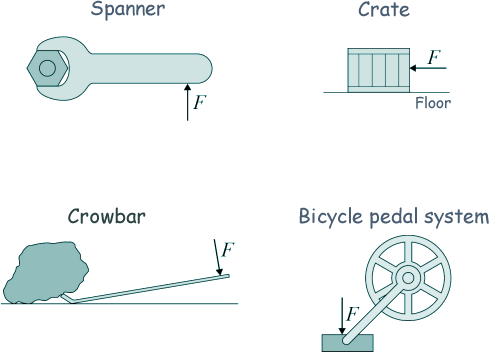GCSE Questions: Moments and Centre of Gravity
Q13. (a) Here are four examples of a force causing an object to move.

Which object is not likely to rotate?
The crate is not likely to rotate. 
[1 mark]
(b) The diagram below shows a simple device that can be used as a weighing scale.
On the right you can see the device being used to measure a quantity of rice.
The weight of the device is balanced by the weight of the rice and basket.

(i) The weight of the device acts through the point labelled X. What is point X called?
X is the centre of mass or centre of gravity of the device. 
[1 mark]
(ii) How does the diagram show that the weight of the device is balanced by the weight of the rice and basket?
The pointer is vertical or the arms are horizonatal 
[1 mark]
(iii) The basket can hang from different points on the device.
These are indicated by letter P, Q, R and S.
Where should the basket hang to measure the largest quantity of rice?
P 
[1 mark]
(iv) Write down the equation which links distance, force and moment of a force.
moment of a force = force x distance from the pivot point
M = Fd 
[1 mark]
(v) In the diagram, the weight of the device causes an anticlockwise moment of 0.15 Nm about the pivot.
The weight of the rice and basket acts 0.06 m from the pivot.
Calculate the weight of the rice and basket.
M = Fd
F = M/d 
F = 0.15/0.06 
F = 2.5 N 
[3 marks]
(vi) Write down the equation which links gravitational field strength, mass and weight.
weight = mass × gravitational field strength
W = mg 
[1 mark]
(vii) The basket has a mass of 0.04 kg.
Given that the gravitational field strength = 9.8 N/kg, calculate the mass of rice in the basket.
Let mT = total mass
W = mTg
mT = W/g
mT = 2.5/9.8 
mT = 0.255 kg 
Mass of basket is given to 2 decimal places so:
Mass of rice = 0.26 - 0.04 = 0.22 kg 
[3 marks]
[12 Marks TOTAL]








